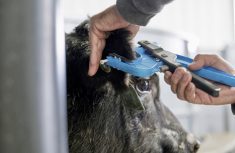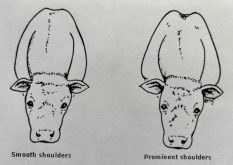It has been said that it is getting harder and harder to make money in the cattle business. Expenses too often outweigh revenue, resulting in limited profit potential. Whether you agree or not, many ranchers are cautious about making additional investments to their management systems. To many, it feels as though mounting demands on how we produce beef are increasingly burdensome. At the same time, technology is advancing at a rapid pace, but return on investment is not always well-defined. This makes it challenging to decide whether to implement these technologies at the ranch level.
Read Also

What to know before you go to Agribition 2025
If you’re attending Agribition 2025, this is the place to find out about tickets, dates and what’s happening this year.
Though cattle production is steeped in tradition, it has also seen remarkable advancements in production and management practices in recent decades. Some of these advancement benefits have been clearcut and have been readily adopted, with immediate and direct impacts on the bottom line. Others have been a point of debate due to questions about their value and impact. Many have been skeptical about progressions in genetic information and selection tools. As a result, considerable opportunities and profit potential are left on the table.
As a beef cattle producer, you are continually making genetic selection decisions in your breeding programs. Some may find these decisions challenging and difficult, others may find them quite easy, but all know the significant implications that poor genetic selection decisions can have on their business. Some may use all the tools available and others may not. Some may feel confident in their decisions, but others may not. For decades, there has been more and more genetic information available to those trying to make breeding decisions — fertility, growth, feed efficiency, disposition, calving ease and carcass measures, to name a few. Use and interpretation of this information can feel overwhelming as variations and shifts in the tools continue to evolve faster than we can adapt in some cases. This has added to the uncertainty and skepticism of the tools and information.
As animal breeders, you undoubtedly know that the observable physical properties of an animal (phenotype) are determined by its genetic potential (genotype) and how that animal is managed (environment), or as geneticists say: phenotype equals genotype plus environment. This is the key concept to understand when considering genetic decisions within your herd.
While the genetics you choose are important, your management heavily influences the optimization of those genetic choices. You can evaluate those decisions with individual animal record-keeping and benchmarking or by comparing the data over time. Only then can genetic decisions be monetized or translated into profit.
All beef breeds capture individual data on economically important traits for beef production, and conduct genetic evaluations to estimate the genetic breeding potential of animals within the breed, which are then reported in the form of EPDs. As data is captured on the animal and its offspring, the accuracy of its performance estimate (EPDs) increases. In other words, the EPD will be more accurate in predicting the resulting expression of traits.
Genetic evaluations and resulting EPDs for the various breeds have evolved as the economically important traits for the specific breeds and the entire beef industry have shifted. The days of pushing for maximum performance are past and we now understand that optimization and balance are more desirable goals. Most of the beef breeds report EPDs on very similar traits (birth weight, calving ease, weaning weight, yearling weight, etc.). However, because these tools were developed to compare and advance the trait within the breed, the EPDs are not necessarily comparable across all breeds.
While genetic evaluations and the EPD model can assist in genetic decisions, it is critical to remember that EPDs are an estimate calculated using large amounts of data across many herds. As the science and calculations improve, so too do the models change and evolve to more accurately estimate genetic potential. It is not an exact science, but it is extremely helpful in choosing genetics that will help you reach your business’s production and profit goals.
As genomic technology has advanced to interpret genotypes from DNA within beef cattle, the accuracy of genetic evaluations has improved, particularly on young animals with limited or no data available on offspring. The genotypic data is commonly integrated into the genetic evaluation to increase the prediction accuracy or the EPD. Therefore, an animal’s DNA or genotype becomes another necessary tool to help you reach your business’s production and profit goals.
The genetic selection tools available to ranchers today are all cumulative and help to make better breeding decisions. No one tool is a silver bullet and none should be used in isolation. Used correctly and collectively, they will move you closer to your business’s goals and help drive profit on the ranch. Continuous improvement and advancements in beef cattle genetics is a reality at both the ranch level and the industry level. Tools will continue to improve and evolve and so too will our breeding strategies. Therefore, we must get comfortable with constant change. We will never complete our job of genetic selection as continuous improvement drives our success.
So what does this all mean for your business? It is clear that genetic selection decisions have significant implications for your production and the resulting profit of your business. Every operation has specific areas for improvement and goals — the genetics you choose are the foundation required to achieve these goals combined with optimum management. Thus, considerable gains (or losses) in profit can be realized through your genetic decisions and so it is worth your time and investment to:
- Define the goals within your operation that will increase profit potential and the impact breeding decisions have on those goals (i.e. improved fertility, increased weaning rate, increased weaning weight, etc.).
- Understand the tools available and how to accurately interpret and use them in your operation.
- Measure the important traits that will help you achieve goals within your herd. Compare them over time (benchmark) to ensure advancements are in the direction you desire.
There is no doubt that genetic improvements have improved production and added value to the Canadian beef industry. There is also no doubt that further genetic improvements can be made and that access to premium genetics is not the limiting factor. The question is: Are you using the optimal genetics within your business to drive increased profit? Implementation, application and continuous progress of innovative genetic improvement tools can achieve your production and profit goals, whether at the individual business level or across the entire industry. You have the resources, but you need to translate them into value.
If you would like to better understand genetic selection tools or have questions, please contact one of the beef breed associations. We would be happy to discuss how you can drive profit through genetics on your ranch.
Sandy Russell is a beef producer and partner in Spring Creek Consulting, as well as the director of business development at the recently formed Canadian Beef Improvement Network. The Canadian Beef Improvement Network includes the Canadian Beef Breeds Council, as well as the Charolais, Hereford, Angus and Simmental breed associations, and aims to communicate information about beef genetics.
















